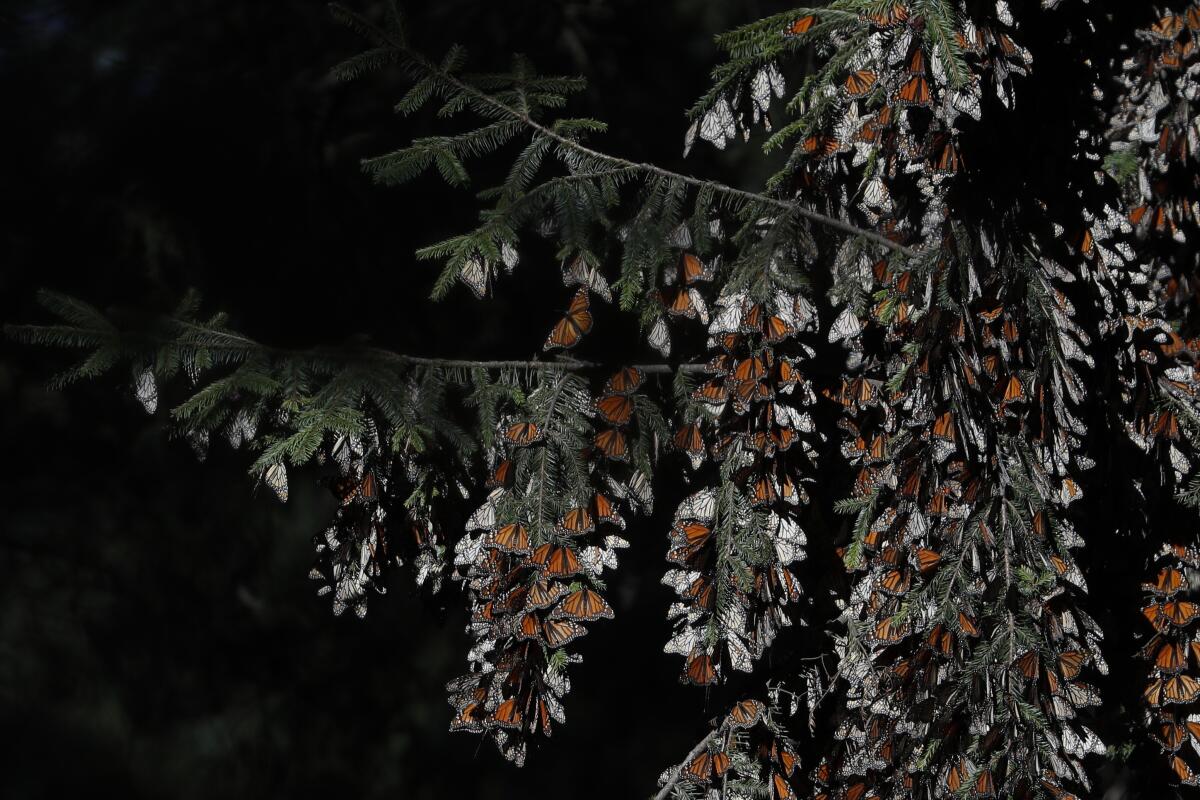Monarch butterfly numbers in Mexico rise by 35%

MEXICO CITY — Mexican experts said Monday that 35% more monarch butterflies arrived this year to spend the winter in the country’s mountaintop forests, compared with the previous season.
Experts say the increase may reflect the butterflies’ ability to adapt to more extreme bouts of heat or drought by varying the date when they leave Mexico.
The government Commission for National Protected Areas said the butterflies’ population covered 7 acres this year, compared to 5.2 acres last year.
The annual butterfly count doesn’t calculate the individual number of butterflies, but rather the number of acres they cover when they clump together on tree boughs.
Each year the monarchs return to the United States and Canada on an annual migration that is threatened by deforestation in Mexico’s butterfly reserves and the loss of the milkweed they rely on for food and habitat north of the border.
Gloria Tavera, the regional director of Mexico’s Commission for National Protected Areas, said logging in the butterflies’ wintering ground rose by about 4.5% this year, to 34 acres.
However, fewer trees were lost to fire, drought or plant diseases and pests. So overall tree loss in the 2021-22 season was about 46 acres, down from the loss of 51 acres in the 2020-21 season.
Monarch butterfly populations are endangered, to the point that the 1.2 million Western monarchs counted in 1997 plummeted to fewer than 2,000 by 2020. Here are ways we can help them survive.
But environmentalist and writer Homero Aridjis, who grew up around the reserve, said “there is no reliable data for the full extent of wood extraction from the reserve,” noting that loggers often take undamaged trees, claiming they were diseased or were affected by storms.
The butterflies traditionally arrive in the mountaintop pine and fir forests west of Mexico City around the beginning of November. They normally leave for the U.S. and Canada in March.
Tavera said that last year was unusual, because the monarchs began leaving in February, before drought and heat hit just north of border in April and May.
“They are beginning to adapt to extreme climate conditions,” Tavera said.
But this year, the butterflies stuck around in Mexico longer than usual.
“They left very late. We still had butterflies in April,” she said. It remains to be seen in next year’s figures whether that strategy worked for them.
The unexpected return of the butterflies to the California coast brings moments of wonder at a time when good news seems rare.
Activists and students in the United States and Canada have been urged to plant milkweed to make up for the losses of the plant due to the clearance of farm and pasture land and the use of herbicides. But that strategy has backfired in Mexico.
Tavera urged the public not to plant milkweed in Mexico, saying it might disrupt the migration by encouraging monarchs to stick around rather than head north. She also urged people not to breed monarchs in captivity — they are sometimes released at weddings or other celebrations — saying that could spread diseases among the insects.
Jorge Rickards of the World Wildlife Fund said that despite the increase in the monarch population this year, “this continues to be a migration phenomenon at risk.”
Over 160,000 tourists visited the butterfly reserves in Mexico in 2021, a 132% increase over the number that visited during in 2020, the first year of the coronavirus pandemic.
The local collective farm groups that own much of the forest in the reserves depend on tourism for income and to discourage logging.
We spent the day with L.A. County’s top monarch butterfly counter, and ask: Can this endangered species survive?
The species’ migration is threatened by drought and severe weather caused by climate change, as well as the loss of habitat — especially of the milkweed where the monarchs lay their eggs — due in part to pesticide and herbicide use.
Illegal logging and loss of tree cover due to disease, drought and storms also continue to plague the reserves.
But Aridjis, the activist, said the reserves are also under pressure from drug cartels and illegal planting of avocado orchards, which thrive in the same general climate as the pine forests.
“There is drug trafficking, and dead bodies regularly turn up on remote paths,” Aridijis said of the area around his hometown of Contepec. “I feel like an exile from my birthplace.”
More to Read
Sign up for Essential California
The most important California stories and recommendations in your inbox every morning.
You may occasionally receive promotional content from the Los Angeles Times.













